 by Diana Ritter
by Diana Ritter
Instructional Partner
Muscle Shoals (AL) City Schools
I know we’ve all been there. We provide quality professional development for our teachers. We spend countless hours training them in best practices. We spend money on the most up-to-date, researched based curriculum materials. We do all this and yet we are left scratching our heads when teachers aren’t as enthusiastic as we thought they would be to implement what we think are fantastic practices, ideas, and strategies.
Don’t get me wrong. I work with some of the best teachers anywhere. I see extraordinary things happening in classrooms each and every day. They embrace new ideas better than any group I’ve ever worked with. They are very, very good at what they do; I would even say incredible.
However, we work in a system with high expectations and with the notion of never settling for the status quo. We are always looking to improve. And sometimes, for various reasons, all the professional development and support we provide still does not help teachers integrate the new learning into their instruction and classrooms like we envisioned.
Is There a More Effective Way?
The question: What can we do to integrate new professional learning better?
Our answer: Put the professional development, ideas, learning, implementation and reflection in the hands of our teachers. Maybe they should control their own growth and professional learning. We are asking students to be leaders of their own learning. So why not expect teachers to do the same?
How it Began
This past fall the instructional partner (IP) at our kindergarten school began to implement Professional Learning Communities (PLCs) with her teachers, designed around their professional learning plans.
She was seeing a lot of success and after sharing what was happening in her school at one of our planning meetings, our assistant superintendent encouraged us to implement something similar in all our schools.
The what, when, and how was left up to individual schools and what each administrator and IP thought would work best in each school. When our assistant superintendent pulled together a “Turnaround Team” last fall to help us hone in on what would have the most impact on our schools, teachers and students, my wheels began to spin and the planning began.
Lesson Study with a Twist
With input from my administrators about what would work best with our teachers, a plan was put in place. There was more groundwork that needed to be laid before we could expect teachers to buy into what we were planning to sell: PLC teams centered around intentional common lesson planning of one lesson that each teacher would go back to the classroom and teach.
If you are thinking this sounds a little like Lesson Study – the Japanese model of long-term professional development where teachers collaboratively research, study, plan, observe, analyze, and reflect on a lesson – you are right.
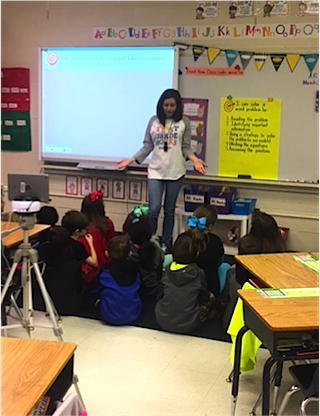 What we are doing is very close to Lesson Study but with one major difference. Instead of having a group of teachers go watch one colleague teach each time they plan a different lesson, in our plan each teacher, at some point, would be asked to use the SWIVL to video their own lesson for individual reflection before the group came back to reflect together.
What we are doing is very close to Lesson Study but with one major difference. Instead of having a group of teachers go watch one colleague teach each time they plan a different lesson, in our plan each teacher, at some point, would be asked to use the SWIVL to video their own lesson for individual reflection before the group came back to reflect together.
Another twist: teachers would be asked to share their video with the group. One of my administrators had already been giving teachers an option of videoing one of their lessons instead of having the administrator actually come in to observe. (The personal reflection from teachers and the feedback he was able to provide was astounding.)
We took this approach because we knew videoing for self-reflection was the key to tremendous professional growth. Videoing may sound a little scary (it did to some of our teachers). However, this is my second year as the instructional partner, working closely with administrators to help build relationships, collaboration, and a culture of growth and trust. Without setting the vision, achieving culture shifts, and making high expectations the norm (thanks to the support of incredible administrators), this level of teacher sharing would not be possible.
Laying the Groundwork
 During the past two years we have spent a lot of time on differentiation, which was an area of focus for our district. We have also done a lot of work with formative assessment and using data to meet students where they are in order to show maximum growth for every single child.
During the past two years we have spent a lot of time on differentiation, which was an area of focus for our district. We have also done a lot of work with formative assessment and using data to meet students where they are in order to show maximum growth for every single child.
We knew we still had a missing puzzle piece. Supporting teachers to really dig deep and understand learning targets helped us find it.
Every teacher got a copy of Ron Berger’s book, Leaders of Their Own Learning. We dug into learning targets and checks for understanding like never before. And the discovery that began to happen among the teachers was this: learning targets determine the direction of the lesson and help us plan and shape instruction. Which in turn requires implementation of high quality, frequent formative assessment during our lessons – surfacing individual student needs that can be addressed right in the moment or on the days that follow.
As teachers began to see the power of learning targets and how they control all aspects of the lesson in the classroom, we knew we had to “hook” them to lay out the next phase of our plan.
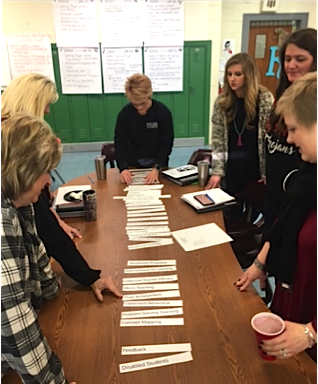 This is where John Hattie’s large-scale research into which teaching and learning strategies work best came into play. I took the first 50 practices from his list of effect sizes, typed them up and cut them out into strips. Without revealing effect size, I had teachers work together to choose a list of 10 that they believed would have the most positive effect on student achievement.
This is where John Hattie’s large-scale research into which teaching and learning strategies work best came into play. I took the first 50 practices from his list of effect sizes, typed them up and cut them out into strips. Without revealing effect size, I had teachers work together to choose a list of 10 that they believed would have the most positive effect on student achievement.
They did great. They actually got several of Hattie’s Top 10 correct. One of the things they did not put in their Top 10 was collective teacher efficacy.
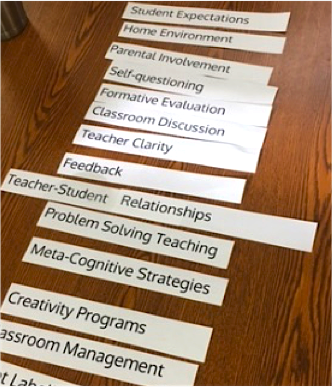 After learning more about this topic at our last ABPC Instructional Partners Network retreat, the goal of my administrators and myself has been to build collective teacher efficacy. What better way to do this than to have teachers help each other, while at the same time learning from those peers with whom they work every day?
After learning more about this topic at our last ABPC Instructional Partners Network retreat, the goal of my administrators and myself has been to build collective teacher efficacy. What better way to do this than to have teachers help each other, while at the same time learning from those peers with whom they work every day?
Using PLCs for intentional lesson planning, teaching, and reflection was how we planned to go about building this collective teacher efficacy. Our thinking: We’ve trained them on all these things and provided them with the support they need to be successful. Now it’s time for them to believe they can make great things happen in their classrooms and with their students and put that belief into practice.
Creating a seamless design
We began with the areas in which we had placed much professional learning focus – individual pieces that are helping improve instruction and thus student learning. What we didn’t have was a way to help our teachers tie these all together seamlessly throughout their lessons.
What exactly does the use of learning targets, with formative assessment and differentiation, look like in a great lesson? That became our next step: helping teachers see how to intentionally plan lessons together that incorporate these three essential lesson components:
► Learning Targets
► Formative Assessment
► Differentiation
One of my principals (I work in two schools) suggested that teachers come up with a list of “Look Fors” for each of these components. He knew what he was and wasn’t seeing when doing evaluations of teachers and by having them think through a list of “what to look for” together, they would have buy-in on what they should expect to see in their lessons.
So in a grade level meeting, I posed this question for each component: “If you were to walk into a classroom and see exceptional use of learning targets, formative assessment, and differentiation, what would you see?” With carefully planned conversation, guidance, and some minor tweaking, we came to the agreement on what would be our list of “Look Fors” in these areas.
Teachers then used these checklists as tools to help them in planning. In addition, I made shared Google Drive folders with each of these components and continuously fill them with research articles, templates, videos, and materials they can pull from when working in their PLC teams and planning their lessons.
The PLC Team Process
The PLC teams are made up of teachers at each grade level. The teams were given very few parameters. They set their own times to meet, set their own agenda, set their own norms, and are now taking on a variety of roles.
The only common requirement is to use the following cycle in their PLCs and do enough cycles to ensure that each teacher videos herself once.
PLC Cycle
► Teachers study/research (if needed) and pre-plan (decide what subject/content/skill they will teach).
► Teachers plan the lesson together using the list of “Look Fors” and materials gathered either from the shared Google Folders or their own research.
► Each teacher teaches the lesson in her own classroom (only one teacher makes a video).
► The teacher who videoed shares it with others in the group and identifies things she would like for the others to look for (this is optional) and reflects upon her videoed lesson.
► Each teacher individually reflects on her own lesson and the videoed lesson (if shared).
► The PLC team meets and discusses the lesson using their self-reflections and examples of student work.
► Adjustments are made and the cycle repeats.
The beauty of teachers all planning a lesson together? They learn from each other, sharing their own thoughts and ideas. In addition, they can be honest about the videoed lesson and the individually taught lessons because it was all planned together. The focus shifts to the lesson, not the presenter of the lesson. Another bonus: the person who has great ideas but never speaks up in a whole group might get a chance to share something that no one else has ever thought of.
Finally, all those great things that we know are already occurring in individual classrooms eventually get shared with everyone.
The Impact
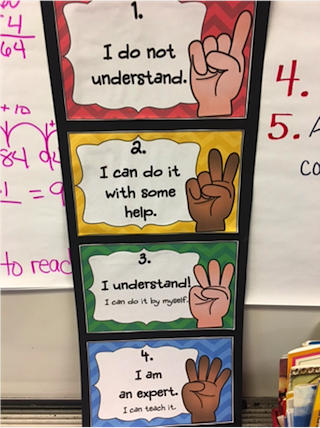 The immediate results of our implementation (grade level lesson-planning PLCs with follow-up professional development) has been quite remarkable. Incredible things have started happening in our classrooms.
The immediate results of our implementation (grade level lesson-planning PLCs with follow-up professional development) has been quite remarkable. Incredible things have started happening in our classrooms.
Learning targets are not only visible, but they are used throughout the lessons by teachers and students. In some instances, teachers are even having students as young as first grade help them write the learning targets for the week.
Checks for understanding such as a 1, 2, 3, 4 are being used consistently. Teachers are using strategic observation forms and learning target self-assessment exit tickets to modify and differentiate instruction. Some classrooms are even using peer critiques with their journal writing. We have seen the need to help students be more specific in their own self checks, and the use of success criteria has been a natural next step in our planning process.
Most importantly I am hearing things like:
- “Thank you – this is one of the best things we have ever done to help improve our instruction.”
- “I think the students did better than ever before on similes because of our intentional planning of the lesson in our PLC.”
- “I love to see how excited my kids are about their learning now.”
- And maybe my favorite: “I see students self-assessing themselves even when I haven’t asked them to.”
 I alluded earlier to the importance of our administrators taking a very engaged role in this PLC process. They, along with myself, are often an active part of the research, planning, and reflection meetings. Videoed lessons are shared with us, many times with teachers asking for specific input, ideas, and thoughts on the lesson. Agenda and meeting notes are shared with us through Google Docs.
I alluded earlier to the importance of our administrators taking a very engaged role in this PLC process. They, along with myself, are often an active part of the research, planning, and reflection meetings. Videoed lessons are shared with us, many times with teachers asking for specific input, ideas, and thoughts on the lesson. Agenda and meeting notes are shared with us through Google Docs.
The key to this success has been the willingness for teachers to take some steps outside their comfort zones and open up about their own strengths and areas where they need to improve. The role of my administrators in the process has also been crucial to getting teachers involved and motivated to continue this challenging work. Everyone understands that this work really matters.
To say I am proud of how these teachers have embraced this challenge and worked diligently to be leaders of their own learning, is an understatement. The level of dialogue and reflection that I hear occurring even outside of their planned PLC meeting times is something I have never witnessed in all my years in education.
I know this is something we can continue to refine and perfect, but for now, we are extremely happy with our work and the direction in which we are heading.
Dianna Ritter has been an educator for almost 15 years. She is currently the Instructional Partner at Highland Park and Webster Elementary Schools in the Muscle Shoals City School District. She is in her second year in that role and has previously taught kindergarten, first, and second grades. In addition, she worked for five years at the University of North Alabama as an AMSTI Math and Science Specialist. You can follow her on Twitter @Dianna_Ritter.

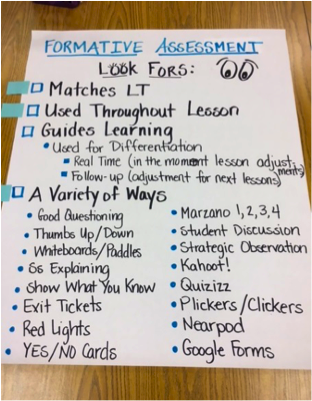
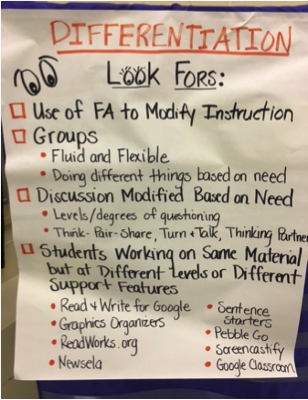
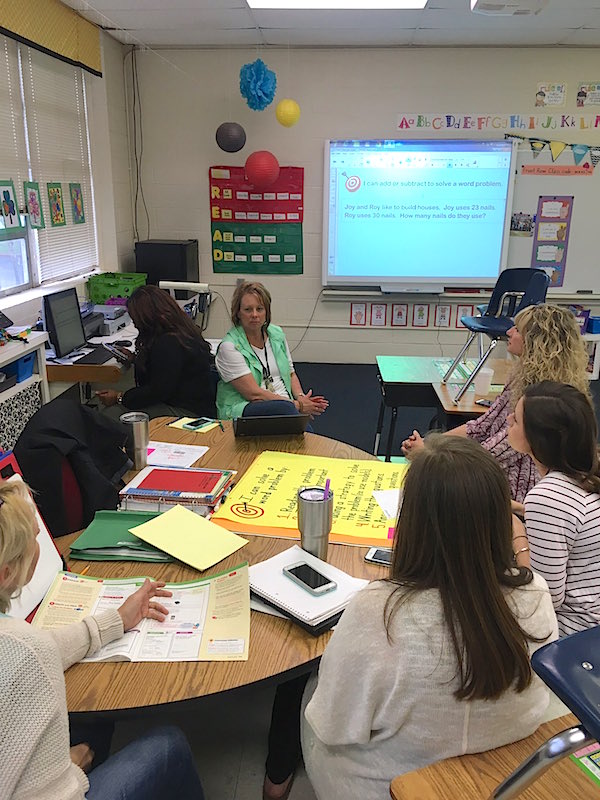

0 Comments on "In Muscle Shoals, PLCs and Lesson Studies Empower Teachers to Lead Their Own Learning"